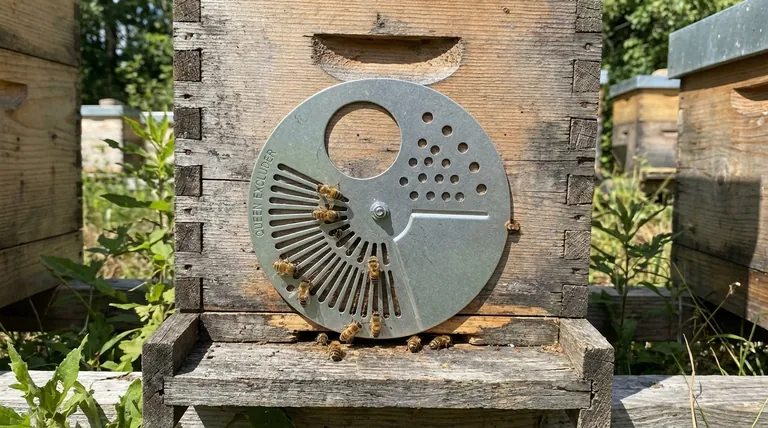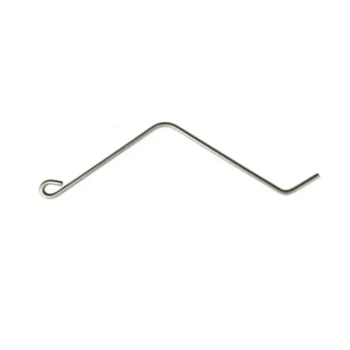To put it simply, the steel top entrance disc for a beehive provides four distinct options for managing the hive's entrance: open access, a queen excluder, a ventilation setting, and a fully closed position. This simple, rotating device allows a beekeeper to control traffic, protect the colony, and adapt to changing conditions with a quick turn.
The core purpose of an entrance disc isn't just to open or close a hive; it's a multi-function tool that gives you precise control over who and what can enter or leave the colony, adapting to the hive's needs throughout the seasons.

Deconstructing the Four Entrance Settings
Each setting on the steel entrance disc serves a specific, strategic purpose in hive management. Understanding the function of each is key to using this tool effectively.
Open Access
This is the largest opening on the disc. It's the default setting for most of the active season when the colony is strong and foraging activity is high.
This full-width opening allows for maximum traffic flow, preventing congestion as worker bees come and go during a heavy nectar flow.
Queen Excluder
This setting consists of a series of slots, wide enough for worker bees to pass through but too narrow for the larger queen or drones.
Its primary use is to prevent the queen from leaving the hive. This is critical during swarm management or when you are introducing a new queen and want to ensure she doesn't abscond.
Ventilation
This option features a grid of small holes. These perforations are too small for any bees to pass through but large enough to allow for significant air exchange.
This setting is invaluable when transporting a hive, as it prevents overheating while keeping the bees securely inside. It's also useful for providing extra ventilation during periods of extreme heat without opening the hive to pests.
Closed
The final setting is a solid, completely blank section of the disc. When rotated to this position, it fully seals the hive entrance.
This is used for moving a hive, especially over short distances or at night. It's also used to protect the colony from external threats, such as nearby pesticide spraying, or to completely prevent robbing from other hives during a dearth.
Understanding the Trade-offs
While incredibly useful, the entrance disc is not a universal solution. It's a tool with specific advantages and limitations that a beekeeper must consider.
Potential for Bottlenecks
Even the "open access" setting is smaller than the full-width entrance on many standard hive bodies. During a peak nectar flow, a very strong colony may experience traffic congestion at the disc, slightly reducing foraging efficiency.
Fixed Entrance Position
The disc is mounted in one location with a screw. This provides a single point of entry and exit, which can be easier for the colony to defend but lacks the flexibility of a full-width entrance that can be reduced with a separate entrance block.
Material Conductance
Being made of steel, the disc can become very hot in direct summer sun or very cold in the winter. While typically not a major issue, it's a physical property that differs from a standard wooden entrance.
Making the Right Choice for Your Goal
Selecting the correct setting is a matter of responding to the immediate needs of your colony and your management goals.
- If your primary focus is peak honey production: Use the open access setting throughout the main nectar flow to maximize foraging traffic.
- If your primary focus is swarm control or requeening: Use the queen excluder setting to keep the queen securely inside the hive.
- If your primary focus is moving the hive: Use the closed setting for short moves or the ventilation setting for longer transport to prevent overheating.
- If your primary focus is colony defense: Use the queen excluder setting to reduce the entrance size, making it easier for the guards to repel robbers or pests.
Ultimately, the steel entrance disc is a versatile and essential piece of equipment for adaptable and responsive beekeeping.
Summary Table:
| Entrance Setting | Primary Function | Key Use Case |
|---|---|---|
| Open Access | Maximum bee traffic | Peak honey production season |
| Queen Excluder | Confine the queen | Swarm control & requeening |
| Ventilation | Airflow without escape | Hive transportation & extreme heat |
| Closed | Complete seal | Moving hives & pest/pesticide protection |
Ready to upgrade your apiary management with professional-grade equipment?
As a trusted wholesale supplier to commercial apiaries and beekeeping equipment distributors, HONESTBEE provides the durable, precision tools you need for efficient, large-scale operations. Our steel entrance discs are built for reliability and strategic hive control.
Contact HONESTBEE today to discuss your wholesale supply needs and discover how our equipment can strengthen your colonies and streamline your beekeeping business.
Visual Guide

Related Products
- Beehive Entrance Reducer Guardian Metal Hive Entrance for Bees
- Multi-Functional Rotary Hive Entrance Disc for Beekeeping
- Multi-Functional Sliding Hive Entrance for Beekeeping
- Long Langstroth Style Horizontal Top Bar Hive for Wholesale
- Professional Galvanized Hive Strap with Secure Locking Buckle for Beekeeping
People Also Ask
- What are the features of the side with oblong holes in the entrance reducer? A Guide to Hive Defense & Health
- What size is the entrance hole in a native bee hive? The 13mm Standard for a Thriving Colony
- How can a Langstroth hive entrance be adjusted? Mimic Natural Bee Preferences for a Healthier Hive
- What are the different entrance sizes for an 8 or 10-frame Langstroth hive? A Guide to Seasonal Management
- What are the different types of entrance reducers available? A Guide to Protecting Your Hive



















